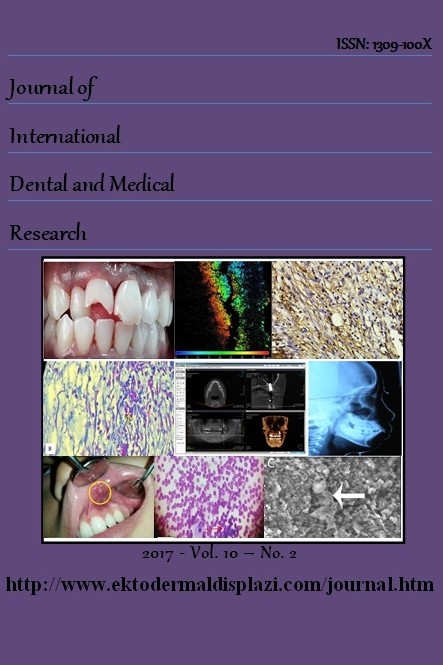Comparative Evaluation of Factors Minimizing the Amount of Needle Deflection During Inferior Alveolar Nerve Block – An In Vitro Study
-
Comparative Evaluation of Factors Minimizing the Amount of Needle Deflection During Inferior Alveolar Nerve Block – An In Vitro Study
___
- Rood JP, Weinstein P,Etidocaine in dentistry, Anesth prog 1989: 36: 171-192.
- Jastak JT, Yagiela JA, Local Anesthesia of the oral cavity, Philadelphia, Saunders, 1995; Edn 2 133.
- Barker BC, Davies PL, The applied anatomy of the petrygomandibular space, Br J Oral Surgery 1972; 10:43-45.
- Roda RS, Banton PL. The anatomy of local anesthesia. Quintessence Int 1994;25:27-38.
- John G Mechaan, Practical dental local anesthesia, Quintessence publishing Co Ltd UK 2010;:5-6.
- A Kingon,* P Sambrook,_ A Goss_ Higher concentration local anaesthetics causing prolonged anaesthesia. Do they? A literature review and case reports , Australian Dental Journal 2011; 56: 348 –3
- Arthur H. Jeske, , Mis -conceptions involving dental anesthesia Texas Dental Journal,2002 ; 4: 296-307.
- Adam Ramford , Bristol Dental Hospital , SAAD DIGEST , volume 23 , JAN 2007 ; 24-25.
- Pushpendra Kumar Verma Anesthetic efficacy of X-tip intraosseous injection using 2% lidocaine with 1:80,000 epinephrine in patients with irreversible pulpitis after inferior alveolar nerve block: A clinical studyJournal of Conservative Dentistry | Mar-Apr 2013; 16( 2):163-165
- Nigel D Robb , Sedation in Relation to Dentistry, SAAD DIGEST 2011;2: (27) : 53.
- Lehtinen R: Penetration of 27- and 30-gauge dental needles. Int J Oral Surg 1983;12: (6)444-445.
- Amereican academy of pediatric dentistry(2009) guidelines in the use of local anaesthesia for paediatric dental; patients. Reference manual, 2009 ; 34 (6) ;1 2 / 1 3; 184-7.
- Marcello Augello et al. Needle breakage during local anesthesia in the oral cavity —a retrospective of the last 50 years with guidelines for treatment and prevention. Clin Oral Invest 2011; 15:3 –8
- Okamoto Y, Takasugi Y, Moriya K, Furuya H,Inferior alveolar nerve block by injection into the pterygomandibularspace anterior to the mandibular foramen: radiographic study of local anesthetic spread in the pterygomandibular space. Anesth Prog 2000; 47(4):130 –133
- Aldous JA: Needle deflection: A factor in the administration of local anesthetics. J Am Dent Assoc 1968 ;77:(3); 602-604.
- Koichi Yoshimura, Development of a tissue-equivalent MRI phantom using carrageenan gel Magn Reson Med 2003; 50:(5)1011 –10
- Robinson SF, Mayhew RB, Crown RD, Hawley RJ, comparative study of deflection characteristitics and fragility of 25-27 and 30 gauge short needle anesthesia, J Am Dent Assoc 1984;(2)109:9209
- Smith N. An investigation of the influence of gauge on some physical properties of hypodermic needle -Relation between gauge and flexibility of the needle .Aust Dent J 1968; 13 : (2)158-163.
- Jeske AH, Boshart BF, Deflection of conventional versus nondeflecting dental needle in vitro, Anesth Prog 1985; 32(1): :62-64.
- Mark N , Hochman In vitro study of needle deflection- A linear insertion versus bidirectional rotational insertion technique , Quintessence International , 2000 ;(1) 31 :33-39.
- Berns JM , Sadove MS .Mandibular block injection , A method of study using an injected radioopaque material ,J Am Dent Assoc 1962 ;(1) 65:735-45.
- Stanley F. Malamed, DDS, Handbook of local anesthesia, Ed.2004;.230-32 Variable* amount of variation 1 5 100 0.245 0.548 0.500 000 2 5 0.700 0.122 0.274 0.500 000 3 5 600 0.245 0.548 000 000 4 5 100 0.245 0.548 0.500 000
- Table Results of sample A. Table Results of sample B. Table Results of sample C. Variable* amount of variation Try Count Mean SE mean St Dev Min Max 1 5 100 0.245 0.548 0.500 000 2 5 600 0.245 0.548 000 000 3 5 400 0.678 517 000 000 Table Results of sample D. 1 5 800 0.490 095 000 000 2 5 000 0.316 0.707 000 000 3 5 800 0.374 0.837 000 000 4 5 800 0.490 095 000 000 Variable* amount of variation 1 5 100 0.245 0.548 0.500 000 2 5 0.700 0.122 0.274 0.500 000 3 5 400 0.245 0.548 000 000
- Başlangıç: 2008
- Yayıncı: Ektodermal Displazi Grubu
Oral Health Attitudes and Behavior Among Dental Students in Ajman, United Arab Emirates
Anesthetic Management of Pregnant Patients with Appendectomy
Feyzi CELİK, Abdullah OGUZ, Zeynep Baysal YİLDİRİM, Abdulmenap GUZEL, Erdal DOGAN, Taner CİFTCİ, İlker Onguc AYCAN
Rehabilitation of Open Bite With Diastema Using Zirconia Ceramic Crowns: Case Report
Sedat GUVEN, Tahir KARAMAN, Mehmet UNAL, İhsan Cemal MELEK
The Usage of Low-Dose Lidocaine Fentanyl in Intravenous Regional Anesthesia
Abdulmenap GUZEL, Feyzi CELİK, Öznur ULUDAG, Erdal DOGAN, Celil ALEMDAR, Besir YİLDİRİM
A Survey on Dental Implant in Use Among UAE and Iranian Dentists
Ayad I.ISMAİL, Musab Hamed SAEED, Sara AFSHARİNİA
Asok MATHEW, Aysha Rashed Ali Al ANSARİ, Ahmed Ali RADAİDEH, Nisha T VARUGHESE
Taskin GURBUZ, Fatih SENGUL, Tevfik DEMİRCİ, Munevver CORUH
Nisu SWASTİKA, Madhuri GAWANDE, Minal CHAUDHARY, Swati PATİL
